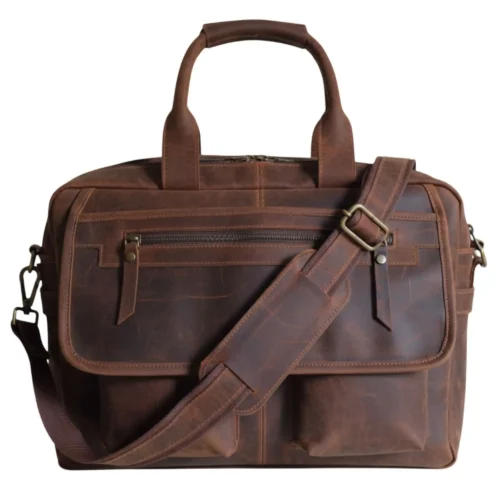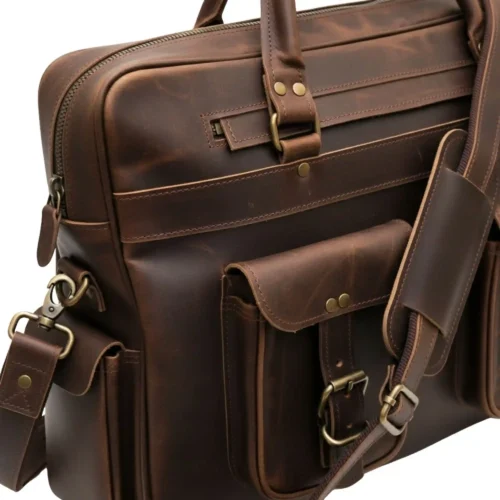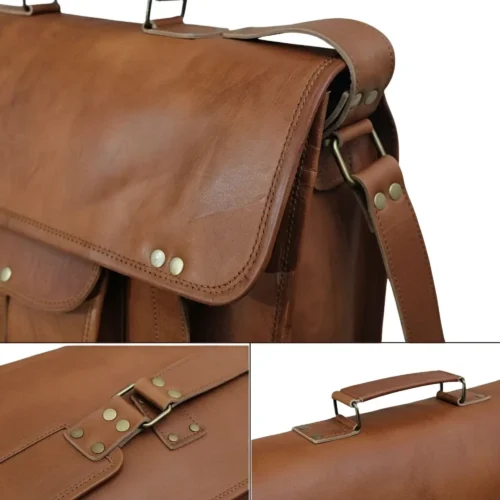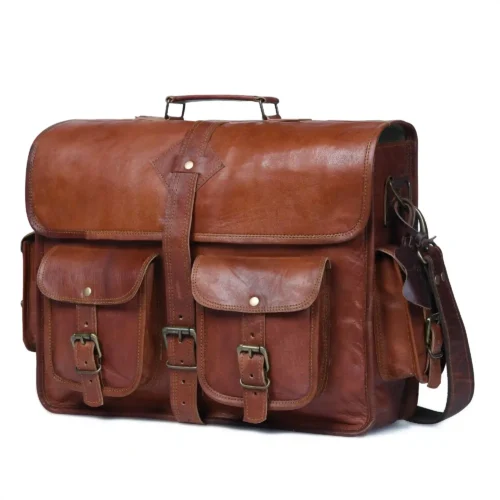
🚛 FREE SHIPPING | LIFETIME REPAIR WARRANTY | 20% Sale: “FREEDOM20”
In a world dominated by factory-made products, traditional leatherworking still holds a special place. Vintage leather bags reflect this legacy of skill, patience, and time-tested techniques. These bags are more than fashion—they are lasting pieces of cultural heritage.
The journey begins with selecting the right leather. Traditional craftsmen knew that quality starts with the hide. They chose classic traveler leather duffle, the strongest and most natural type. This top layer of the hide retains all the grain, texture, and natural marks.
Full-grain leather is durable and develops a beautiful patina over time. That’s why it was the material of choice for most vintage leather bags. Unlike cheaper alternatives, this leather ages gracefully and lasts for decades.
Craftsmen examined each hide carefully. They looked for even grain, the right thickness, and minimal scarring. Cowhide was most common, but goat and lamb were also used for special pieces.
Old-school leatherworkers didn’t use harsh chemicals. They used vegetable tanning, a natural process that relied on tree bark extracts like oak or chestnut. This slow process could take months—but the results were worth it.
Vegetable-tanned leather is rich in color, eco-friendly, and long-lasting. It absorbs oils and develops a unique patina over time. That’s part of what gives vintage leather bags their charm and personality.
Instead of rushing, artisans soaked hides in natural solutions. The leather absorbed the tannins gradually, resulting in flexible, strong material.
The most distinctive feature of vintage leather bags lies in their hand-stitched construction, particularly the use of saddle stitching techniques that date back centuries. This labor-intensive method required considerable skill and represented a fundamental difference from modern machine production.
Saddle stitching involves using two needles and waxed thread, with each stitch interlocking to create exceptional strength and durability. The waxed thread not only provided superior holding power but also offered natural water resistance, contributing to the bag’s longevity. This technique ensured that even if one stitch failed, the surrounding stitches would maintain the bag’s integrity.
Traditional craftsmen used specialized tools for this process, including pricking irons and awls to mark even stitch lines and pierce the leather with precision. The spacing and angle of each stitch required careful calculation to ensure both strength and aesthetic appeal. This attention to detail resulted in seams that could withstand decades of use while maintaining their appearance.
The hand-stitching process also allowed for greater control over tension and placement, enabling craftsmen to reinforce stress points and create decorative elements simultaneously. Many vintage bags feature contrast stitching or specialized stitch patterns that serve both functional and aesthetic purposes.
One of the most telling signs of traditional craftsmanship in vintage leather bags is the quality of edge finishing. This process involved sealing, smoothing, and polishing the raw edges of leather pieces to create a professional, refined appearance while preventing fraying and moisture penetration.
Traditional edge finishing required specialized tools including burnishers made from wood, bone, or brass, along with edge slickers that created smooth, rounded edges. The process typically involved multiple steps: first cutting the edge cleanly, then applying edge paint or dye, followed by careful sanding and burnishing to achieve a glass-like finish.
Master craftsmen often used heated burnishers to compress the leather fibers at the edge, creating a naturally sealed surface that required no additional coating. This technique demanded considerable skill to avoid burning the leather while achieving the desired smooth finish. The resulting edges not only looked professional but also contributed significantly to the bag’s durability by preventing water and dirt infiltration.
Traditional leather bag construction required exceptional skill in pattern making and cutting techniques. Master craftsmen developed and refined patterns over years of experience, understanding how leather behaves under stress and how different cuts would affect the final product’s appearance and functionality.
Cutting knives and rotary blades were meticulously maintained and sharpened to ensure clean, precise cuts. The angle and pressure of each cut had to be carefully controlled to avoid rough edges that would compromise the final product’s quality. Traditional craftsmen often used templates made from durable materials, refined over time to achieve optimal material usage and structural integrity.
The cutting process also involved understanding the natural characteristics of each hide, positioning pattern pieces to take advantage of the leather’s strength and grain direction. Experienced craftsmen could read the leather, identifying areas suitable for different parts of the bag and avoiding flaws that might compromise durability.
Vintage leather bags distinguished themselves through the quality of their hardware, with traditional craftsmen selecting components based on durability, functionality, and aesthetic compatibility with the leather. Solid brass and stainless steel hardware dominated quality vintage pieces, chosen for their corrosion resistance and ability to develop an attractive patina over time.
The installation of hardware required specialized techniques to ensure proper alignment and secure attachment without compromising the leather’s integrity. Traditional methods involved careful measurement, precise hole punching, and often hand-riveting to create permanent, secure connections. The hardware was typically thicker and more substantial than modern alternatives, designed to withstand decades of regular use.
Buckles, clasps, and other functional hardware were selected not just for their appearance but for their mechanical reliability. Traditional craftsmen understood that hardware failure could render an otherwise excellent bag unusable, so they invested in components that matched the leather’s expected lifespan.
Creating the three-dimensional structure of vintage leather bags required sophisticated understanding of how leather responds to manipulation and forming techniques. Traditional craftsmen employed various methods to shape flat leather pieces into functional bag forms, including wet molding, blocking, and careful stretching.
Wet molding involved dampening the leather to make it temporarily pliable, then shaping it around forms or blocks to achieve the desired contours. This process required careful timing – too wet and the leather might tear; too dry and it wouldn’t hold the new shape. Master craftsmen developed an intuitive understanding of their materials, knowing exactly how much moisture to apply and when to begin shaping.
The forming process also involved strategic placement of seams and darts to create smooth curves and eliminate bulk at junction points. Traditional construction methods emphasized clean lines and elegant proportions, achieved through careful planning and skilled execution rather than relying on stiffening materials or shortcuts.
The final appearance and protective qualities of vintage leather bags resulted from carefully executed finishing processes that required both technical knowledge and artistic sensibility. Hand-dyeing techniques allowed craftsmen to achieve rich, even coloration that enhanced the leather’s natural beauty while providing additional protection.
Traditional dyeing involved multiple applications of color, building up layers to achieve depth and consistency. The process required understanding how different leather types absorbed dye and how various environmental factors affected the final result. Master craftsmen often developed their own dye recipes and application techniques, creating signature looks that distinguished their work.
Following dyeing, bags received treatments with oils and waxes to maintain leather suppleness and provide water resistance. These natural treatments penetrated deep into the leather fibers, nourishing the material and helping it develop that characteristic patina over time. The selection and application of these finishing treatments required considerable expertise to achieve optimal protection without compromising the leather’s breathability or appearance.
Traditional leather craftsmanship emphasized rigorous quality control at every stage of production. Each bag underwent careful inspection, with craftsmen checking stitch tension, edge finishing, hardware alignment, and overall construction quality. This attention to detail ensured that every piece met the high standards expected of premium leather goods.
The inspection process involved not just visual examination but also functional testing. Craftsmen would test zippers, clasps, and other moving parts to ensure smooth operation. They checked the bag’s balance when loaded and verified that handles and straps were securely attached and properly positioned for comfortable carrying.
Traditional leather bag making techniques varied significantly across different regions and cultures, each contributing unique methods and aesthetic approaches to the craft. Moroccan leatherwork featured bold colors and geometric patterns, while Japanese techniques emphasized minimalism and precision. These cultural influences created distinctive regional styles that are highly prized in vintage collections today.
The transmission of knowledge from master to apprentice ensured that techniques were preserved and refined over generations. This mentorship system created a deep understanding of materials and methods that went far beyond simple instruction, encompassing the philosophy and artistic vision that elevated craft to art.
Today’s appreciation for vintage leather bags stems largely from recognition of the superior craftsmanship embodied in traditional techniques. The labor-intensive processes and attention to detail characteristic of vintage pieces stand in stark contrast to modern mass production methods.
Contemporary leather workers and enthusiasts increasingly recognize that traditional techniques produced bags with exceptional durability and character. The time investment required for hand-stitching, edge finishing, and proper construction created pieces that improve with age rather than deteriorating, justifying their reputation as lifetime investments.
As interest in vintage leather bags continues to grow, efforts to preserve and revive traditional craftsmanship techniques have gained momentum. Modern artisans study vintage pieces to understand construction methods, while educational institutions offer courses in traditional leather working to ensure these skills aren’t lost to automation.
The documentation and preservation of traditional techniques serves not just historical interest but practical application, as contemporary craftsmen recognize the superior results achieved through time-tested methods. This revival ensures that the artistry behind vintage leather bags continues to inform and inspire future generations of leather workers.
The craftsmanship behind vintage leather bags represents a convergence of material knowledge, technical skill, and artistic vision that produced accessories of unparalleled quality and character. From the careful selection of full-grain leather to the meticulous hand-stitching and finishing processes, every aspect of traditional construction contributed to creating pieces that have retained their beauty and functionality across decades of use.
Understanding these traditional techniques helps explain why vintage leather bags continue to command respect and premium prices in today’s market. They represent not just fashion accessories but tangible connections to a time when craftsmanship was valued over speed, and quality took precedence over quantity. For collectors, enthusiasts, and anyone who appreciates fine craftsmanship, vintage leather bags offer a window into a world where the maker’s skill and dedication were embedded in every stitch, creating objects of lasting beauty and enduring utility.
The legacy of traditional leather craftsmanship lives on in these remarkable pieces, reminding us that true quality comes from the marriage of superior materials, time-tested techniques, and the irreplaceable human touch of skilled artisans who took pride in their craft.
Vintage leather bags stand out due to their use of premium full-grain leather, hand-stitched construction, and time-honored tanning and finishing techniques that ensure durability and beauty over time.
Most vintage leather bags are crafted from full-grain leather, which is the highest quality part of the hide. It retains natural grain, is highly durable, and develops a rich patina with age.
Unlike many modern bags made through automated processes with lower-quality leather, vintage bags are handmade using traditional methods like saddle stitching and vegetable tanning, resulting in superior durability and character.
Vegetable tanning is a natural leather preservation process using tannins from tree bark. It creates rich color, a unique texture, and allows the leather to age beautifully—qualities prized in vintage bags.
Hand-stitching, particularly saddle stitching, offers unmatched strength and longevity. It allows each stitch to hold independently, ensuring the bag remains intact even under stress.






